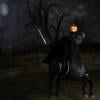hi does anyone know how to light a lamp in iray daz studio
 lasagnaman
Posts: 1,001
lasagnaman
Posts: 1,001
i been trying and trying to get my lamps to light up but they just wont light up
i know iam doing something wrong can someone please help me
in other words i would like to get a dark scene and light the lamp in iray thanks so much
Post edited by Chohole on


Comments
In the Surfaces Tab after you find the geometry that has the mesh part of the model that is supposed to be lit you'll usually find in the various surfaces defined for that mesh one called 'lightbulb' or something similar. Sometimes I have to search through many surfaces on the different model parts to find the light bulbs.
Once found, on the surface, scroll down to the 'Emission' color. It will be black, change it to white & you have light from that surface. It defaults to 6500K temperature which is OK for sunlight at noon on a clear day or indoor lights in the Far East but in the USA & west indoor lights are usually about 2700K to 3000K.
You may need to increase or decrease the brightness of the light(s) too. It defaults to 1500 cd/m2 but you might want to change the unit of measure to something your are familiar with like W for watts or lm for Lumens.
Moved to the Daz Studio forum because it is not an offer of a freebie.
If your lamp has a flame, you might be able to use the surface tool to click on the flame in the scene in order to select the proper surface in the Surfaces tab. If not, you'll need to do as nonesuch said and look through all the surfaces to find the right one.
Anyway, once you're there, notice how some of the channel settings for the surface have little squares showing a tiny picure of the image texture currently applied to the surface. If you can find and click on the one on the base diffiuse color channel, a drop-down menu will appear with a list of image file names, and the one used there in that channel will be marked. Make a note of its name.
Make sure the disclosure triangle beside the surface name points down (you may have to click on it) to reveal a list of categories. When the surface name is selected, all channels in the shader are shown; when you click on one of the categories under it, only that group of the channels appears. Find the category named "Emissive" or "Emission" (I'm at work now and can't remember exactly) and click on it. Then click on the image square in the emission color channel, and in the drop-down menu choose the same graphic image file name you found in the diffuse channel. We're trying to put the same image in both the diffuse color and emissive color channels.
Once that is done, set the color temperature to within the 2700K to 3000K range nonesuch suggested, and change the pulldown that says "cd/m^2" to "Kcd/m^2". Then switch to the Iray preview to see if the glow is to your liking.
I know these instructions are complex and would be better with pictures. Speak up if you have difficulty.
I leave this here as a cautionary tale. I did not understand the whole concept of emission on surfaces. For every scene I have done I have meticulously created individual point light spheres and then point light points (1st one to make it seem like there is a bulb in there and the second to actually provide light without making the bulb as bright as the sun). Dozens and dozens and dozens of hours of my life wasted because I am dumber than a box of rocks. Don't be like me. As previous posters mentioned you just need to change the emission color on the bulb surfaces to white and then set your temp and luminosity to what you want. Excuse me while I beat my head into a brick wall.
lots of stuff isn't necessarily transparent..
years ago when I first started one of the first things I build was a theatrical lighing array.. and it would never work in prevew...
because openGL has an 8 light limit...
---
took a while to figure that out.
---
and back then having to adjust fall off etc.
----
but you can make the lightbulbs .. you can make the ceiling emit light
one of first things I build when iray appeared was some flourescent light fixures..
---
only lighting in this scene is the flurescent units
Well, I've done the just make the bulbs emissive lots of times. It works pretty well. What works a bit better in my opinion is to make the bulbs just emissive enough so you can see the light is on, then I use Ghost Light spheres at each lit fixture that I wasnt to show as lit. I think the light is a bit softer than using points.
There's a lot of different options.
Make the "light bulb"(if it has one) an emissive, is the fastest and easiest, but not always the 'right' solution. Might also want to put a low level emissive on the shade as well to enhance the effect, or adjust the opacity up/down to allow/restrict spill.
A point light might work better, especially with a glass shader applied to the 'bulb'.
Using a pair of spot lights, one pointing up one pointing down, with a point or emissive at the "lightbulb" might create a better look, and provide better control.
A series of "ghost lights", surfaces with emissive enabled, might be the better solution.
And don't forget about IES profiles,Emission profile under surfaces tab, as those can enhance a light outputs to be a bit more "accurate".